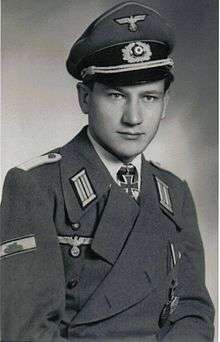Johannes Lutz
| Johannes "Johann" Lutz | |
|---|---|
 | |
| Born |
11 March 1920 Laisacker |
| Died |
26 August 2005 (aged 85) Augsburg |
| Allegiance |
|
| Service/branch |
Heer Bundeswehr |
| Years of service | 1938–45, –1976 |
| Rank |
Leutnant (Wehrmacht) Oberstleutnant (Bundeswehr) |
| Unit | 116th Panzer Division |
| Battles/wars | |
| Awards | Knight's Cross of the Iron Cross |
Johannes "Johann" Lutz[Note 1] (11 March 1920 – 26 August 2005) was a highly decorated Leutnant in the Wehrmacht during World War II. He was also known as the Panzerknacker of Battle of Hürtgen Forest and recipient of the Knight's Cross of the Iron Cross. The Knight's Cross of the Iron Cross was awarded to recognise extreme battlefield bravery or successful military leadership. Lutz was captured by US forces in April 1945 and was held until November 1945.
1926–45
Between 1926 and 1938 Lutz visited the school where he was trained for his profession. On 1 April he was subscribed to the 'Reichsarbeitsdienst', where he served for the 'Reicharbeitsdienstabteilung' 2/285 in Scheinfeld.
On 1 October 1938 he quit the service. Shortly after this on November the 17th 1938 he entered the service of the 'Wehrmacht' at the 7th Infantry-Regiment 63 in Ingolstadt. There he was trained as a machine gunner. From the on-set of the war he participated in the Invasion of Poland as a MG-1 gunner. During the Battle of France he acted as a group leader. On 11 October 1940 the second battalion was incorporated into the 'Kradschützenbataillon'.
At the beginning of the campaign in the Soviet Union, Lutz was the leader of the 3rd infantry group to the 'Kradschützenbatallion 17'. As early as the 2 July 1941 he was awarded the Iron Cross 2nd Class. Later on Lutz was transferred to the 6th 'Panzergrenadier-Regiment 63', where he served as the leader of a company. At Orel Lutz was awarded the Iron Cross 1st Class, on the 28 August 1942. In 1943 Lutz was trained as an officer at the gun-school in Ohrdruf in Thuringia and in Groß Glienicke near Berlin. In 1944 he participated in a master course for technical tank officers at the Panzertruppenschule Krampnitz. After the beginning of the Invasion of Normandy in 1944 Lutz was assigned as a troop leader for the first troop of the 'Divisionsbegleitkompanie' of the 116th Panzer Division. With the division he fought at Arnhem and later in the bloody battles in the Eifel.
In the combat zone of Aachen he was awarded with the Knights Cross of the Iron Cross on 9 December 1944 for the occupation and protection of Vossenack. During this fight in Hürtgenwald he destroyed 5 US Tanks within one day. Following this the first troop of the 'Divisionsbegleitkompanie' was signed into the 'Ehrenblatt' of the 116 tank division. After this Lutz became company leader and first lieutenant and fought in the Ruhr Pocket. On 20 April 1945 Lutz became an American prisoner of war, at this point he served as adjutant to the combat commander in the Harz mountains.
Awards and decorations
- Panzer Badge in Bronze (22 May 1942)
- Iron Cross (1939)
- Wound Badge (1939)
- in Black (11 November 1941)
- in Silver (9 November 1944)
- Close Combat Clasp
- in Bronze (1944)
- Eastern Front Medal (20 July 1942)
- Tank Destruction Badge for Individual Combatants
- Five on 28 October 1944
- Knight's Cross of the Iron Cross on 9 December 1944 as Leutnant and Zugführer (platoon leader) in the Divisions-Begleit-Kompanie of the 116. Panzer-Division[2][3][4]
Notes
References
Citations
Bibliography
- Federl, Christian (2000). Die Ritterkreuzträger der Deutschen Panzerdivisionen 1939–1945 Die Panzertruppe [The Knight's Cross Bearers of the German Panzer Divisions 1939–1945 The Panzer Force] (in German). Zweibrücken, Germany: VDM Heinz Nickel. ISBN 978-3-925480-43-0.
- Fellgiebel, Walther-Peer (2000) [1986]. Die Träger des Ritterkreuzes des Eisernen Kreuzes 1939–1945 — Die Inhaber der höchsten Auszeichnung des Zweiten Weltkrieges aller Wehrmachtteile [The Bearers of the Knight's Cross of the Iron Cross 1939–1945 — The Owners of the Highest Award of the Second World War of all Wehrmacht Branches] (in German). Friedberg, Germany: Podzun-Pallas. ISBN 978-3-7909-0284-6.
- Fellgiebel, Walther-Peer; C. F., Colton; Rogers, Duncan (2003). Elite of the Third Reich: the recipients of the Knight's Cross of the Iron Cross, 1939–45. Helion & Company Limited. ISBN 978-1-874622-46-8.
- Scherzer, Veit (2007). Die Ritterkreuzträger 1939–1945 Die Inhaber des Ritterkreuzes des Eisernen Kreuzes 1939 von Heer, Luftwaffe, Kriegsmarine, Waffen-SS, Volkssturm sowie mit Deutschland verbündeter Streitkräfte nach den Unterlagen des Bundesarchives [The Knight's Cross Bearers 1939–1945 The Holders of the Knight's Cross of the Iron Cross 1939 by Army, Air Force, Navy, Waffen-SS, Volkssturm and Allied Forces with Germany According to the Documents of the Federal Archives] (in German). Jena, Germany: Scherzers Miltaer-Verlag. ISBN 978-3-938845-17-2.
- Von Seemen, Gerhard (1976). Die Ritterkreuzträger 1939–1945 : die Ritterkreuzträger sämtlicher Wehrmachtteile, Brillanten-, Schwerter- und Eichenlaubträger in der Reihenfolge der Verleihung : Anhang mit Verleihungsbestimmungen und weiteren Angaben [The Knight's Cross Bearers 1939–1945 : The Knight's Cross Bearers of All the Armed Services, Diamonds, Swords and Oak Leaves Bearers in the Order of Presentation: Appendix with Further Information and Presentation Requirements] (in German). Friedberg, Germany: Podzun-Verlag. ISBN 978-3-7909-0051-4.
External links
| ||||||||||||||||||||||||||||